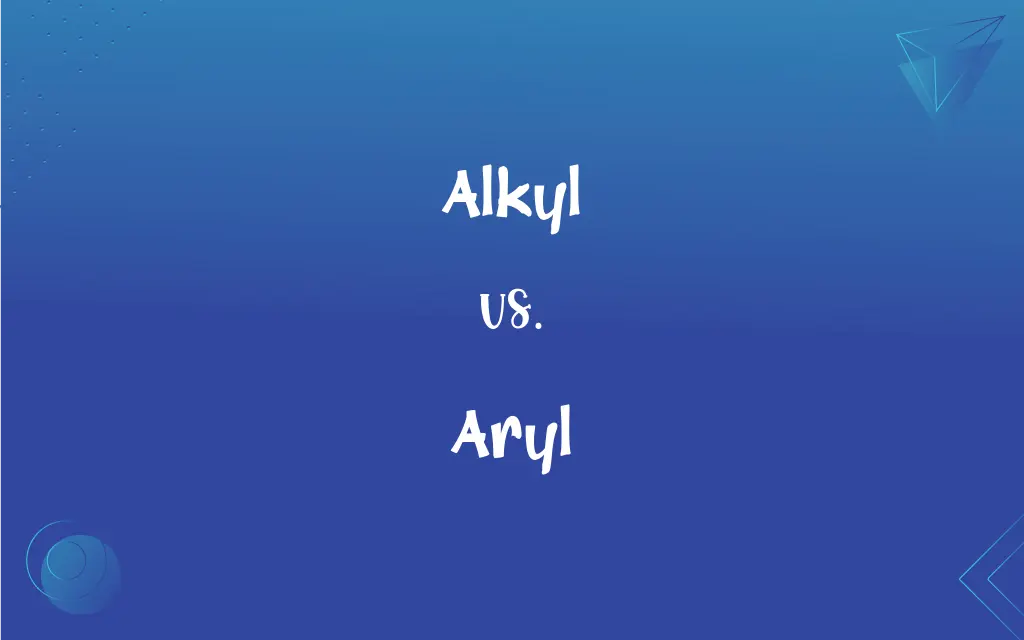Alkyl vs. Aryl: What's the Difference?
Edited by Aimie Carlson || By Harlon Moss || Updated on October 24, 2023
Alkyl is a saturated hydrocarbon group without a ring structure, while aryl is an unsaturated hydrocarbon group derived from aromatic rings.

Key Differences
Alkyl and aryl are both important terms in the realm of organic chemistry, representing two different types of hydrocarbon groups. Alkyl groups are derived from alkanes by the removal of a hydrogen atom and lack aromaticity. On the other hand, aryl groups are derived from aromatic compounds, particularly the simplest aromatic hydrocarbon, benzene, and retain the characteristic aromatic ring structure.
Alkyl groups are generally saturated, meaning they contain single bonds only and are sp3 hybridized. Aryl groups, in contrast, possess the unique aromaticity associated with resonance or delocalization of electrons within a cyclic, planar system. This aromaticity in aryl groups confers stability and distinguishes them from simple alkenes or alkynes.
The physical and chemical properties of molecules can be significantly affected by the presence of either an alkyl or an aryl group. Alkyl groups tend to be non-polar and can increase the hydrophobic nature of molecules. Aryl groups, due to their resonance structures, can participate in a variety of reactions characteristic of aromatic compounds and can influence the electronic properties of molecules.
In terms of nomenclature, alkyl groups are often represented by the letter "R" in structural formulas. For example, an alkyl group derived from methane (CH4) is termed a methyl group (CH3-). Aryl groups, being derived from aromatic hydrocarbons, often carry names like phenyl for the group derived from benzene (C6H5-).
Comparison Chart
Origin
Derived from alkanes.
Derived from aromatic compounds.
ADVERTISEMENT
Bonding
Saturated (single bonds only).
Unsaturated (aromatic ring structure).
Hybridization
Sp3 hybridized.
Sp2 hybridized due to aromaticity.
Typical Representation
"R" in structural formulas.
Often represented by a benzene ring or "Ph".
Stability
Generally stable, without aromatic stability.
Has aromatic stability due to resonance.
Alkyl and Aryl Definitions
Alkyl
A saturated hydrocarbon group.
The alkyl group in propane is propyl.
ADVERTISEMENT
Aryl
Contains a planar ring structure with resonance.
The stability of aryl groups is attributed to their resonance structures.
Alkyl
Derived from alkanes by removing a hydrogen atom.
When a hydrogen atom is removed from methane, the resulting alkyl group is methyl.
Aryl
An unsaturated hydrocarbon group with an aromatic ring.
The phenyl group is a common aryl derived from benzene.
Alkyl
Contains single bonds only.
The alkyl chain in butane consists of single bonds.
Aryl
Derived from aromatic compounds.
An aryl group can be derived by removing a hydrogen from a benzene ring.
Alkyl
Lacks the structure of aromatic rings.
Unlike aryl groups, alkyl groups do not contain benzene-like rings.
Aryl
Exhibits aromaticity and associated stability.
Aryl groups, like phenyl, exhibit a special type of stability due to their aromatic nature.
Alkyl
Represented by the letter "R" in formulas.
In the compound R-OH, R stands for any alkyl group.
Aryl
Often represented by "Ph" or a benzene ring in formulas.
In the compound Ph-OH, Ph stands for a phenyl aryl group.
Alkyl
A univalent group, such as ethyl or propyl, having the general formula CnH2n+1.
Aryl
A compound containing benzene or another aromatic hydrocarbon, or a univalent group derived from such a compound by removal of a hydrogen atom attached to the aromatic ring.
Alkyl
(organic chemistry) Any of a series of univalent radicals of the general formula CnH2n+1 derived from aliphatic hydrocarbons.
Aryl
(organic chemistry) Any univalent organic radical derived from an aromatic hydrocarbon by removing a hydrogen atom.
Alkyl
Any of a series of univalent groups of the general formula CnH2n+1 derived from aliphatic hydrocarbons
FAQs
Do alkyl groups possess aromaticity?
No, alkyl groups lack the characteristic aromatic ring structure and do not exhibit aromaticity.
Is "R" always representative of an alkyl group?
In organic chemistry, "R" is a general placeholder for any alkyl group, but its specific nature should be determined from context.
Are aryl groups always based on benzene?
While the most common aryl group, phenyl, is derived from benzene, aryl groups can be based on other aromatic compounds as well.
Are all alkyl groups the same?
No, alkyl groups can vary in size and structure, such as methyl, ethyl, propyl, etc.
Can alkyl groups increase the hydrophobic nature of molecules?
Yes, alkyl groups being non-polar can increase the hydrophobicity of molecules.
Are all aryl groups derived from benzene?
No, while many aryl groups like phenyl are derived from benzene, others can come from different aromatic compounds.
Are alkyl groups always linear?
No, alkyl groups can be linear, branched, or even cyclic.
Can alkyl and aryl groups be found in the same molecule?
Yes, many organic compounds can contain both alkyl and aryl groups.
Are both alkyl and aryl hydrocarbon groups?
Yes, both alkyl and aryl are types of hydrocarbon groups.
Do aryl groups only exist in aromatic hydrocarbons?
No, aryl groups can be found in a variety of compounds, not just aromatic hydrocarbons.
Can aryl groups participate in electrophilic aromatic substitution?
Yes, due to their aromatic nature, aryl groups can participate in electrophilic aromatic substitution reactions.
Can an aryl group be attached to another aryl group?
Yes, biaryl compounds exist where two aryl groups are connected, either directly or through a linker.
Why are aryl groups considered unsaturated?
Aryl groups are considered unsaturated because they have delocalized electrons in a cyclic, planar system, characteristic of aromaticity.
How does one distinguish an alkyl from an aryl group in a compound?
Alkyl groups lack aromatic ring structures and are saturated, while aryl groups have an aromatic ring.
Why are aryl halides less reactive than alkyl halides in nucleophilic substitution reactions?
Aryl halides are less reactive due to the partial double bond character between the carbon and the halogen, resulting from resonance.
Are alkyl groups electron-donating or withdrawing?
Alkyl groups are generally electron-donating due to the inductive effect.
What distinguishes alkyl from alkenes or alkynes?
Alkyl groups are saturated with single bonds only, while alkenes and alkynes have double or triple bonds, respectively.
Are alkyl groups more reactive than aryl groups?
Generally, alkyl groups are less reactive than aryl groups, especially in electrophilic substitution reactions, due to the lack of aromaticity.
Is a phenyl group an example of an aryl group?
Yes, a phenyl group is a common example of an aryl group derived from benzene.
Which is bulkier, an alkyl or aryl group?
It depends on the specific groups being compared, but in general, larger alkyl groups can be bulkier than a simple aryl group like phenyl.
About Author
Written by
Harlon MossHarlon is a seasoned quality moderator and accomplished content writer for Difference Wiki. An alumnus of the prestigious University of California, he earned his degree in Computer Science. Leveraging his academic background, Harlon brings a meticulous and informed perspective to his work, ensuring content accuracy and excellence.
Edited by
Aimie CarlsonAimie Carlson, holding a master's degree in English literature, is a fervent English language enthusiast. She lends her writing talents to Difference Wiki, a prominent website that specializes in comparisons, offering readers insightful analyses that both captivate and inform.































































